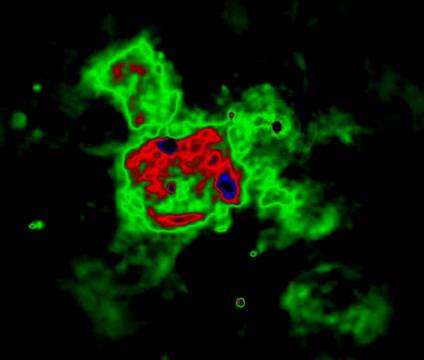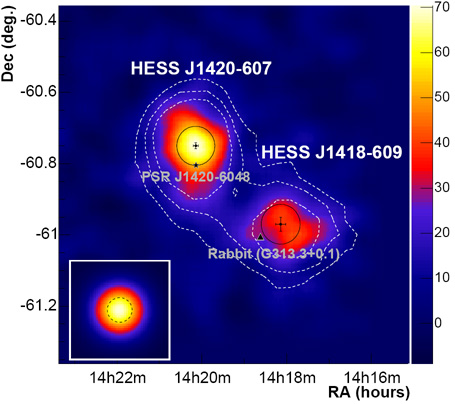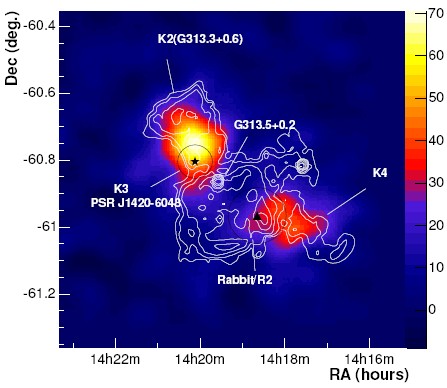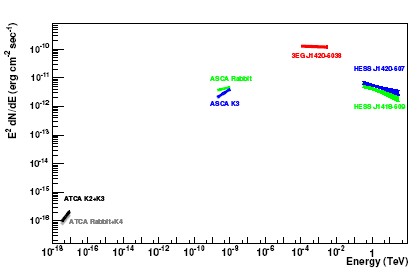The Wings of the Kookaburra
April 2006

Interest in the region around Galactic longitude 313o arose initially since it contains unidentified EGRET gamma-ray sources emitting in the energy range of tens of MeV to GeV. The EGRET sources have a long history; first reported as 2EGS J1418-6049 in the supplement to the 2nd EGRET catalog (Thompson et al. 1996), a source was then recognized as the GeV source GeV J1417-6100 at a slightly different position (Lamb and Macomb 1997), and was in the 3rd EGRET catalog resolved into two sources, 3EG J1420−6038 and 3EG J1410-6147 (Hartman et al. 1999). Observations in radio and X-rays revealed the complex structure shown above, composed of a mixture of compact and extended radio sources and X-ray sources (Roberts et al. 1999). In the north wing of the Kookaburra,D'Amico et al. 2001 discovered the radio pulsar PSR J1420-6048 at a distance of 5.6 kpc, which presumably is one of the sources energizing the complex (Roberts et al. 2001). High-resolution X-ray imaging showed an X-ray nebula surrounding the pulsar. The southern source - the "Rabbit" - was resolved into two X-ray sources, on of them again surrounded by an X-ray nebula (Ng et al. 2005), with a marginal detection of pulsed emission. Hence, the Rabbit is probably also a pulsar wind nebula.
First H.E.S.S. data on the Kookaburra region were gathered as part of an extension of theH.E.S.S. Galactic Plane survey between April and July 2005, covering the longitude range from 300o to 330o. An initial gamma-ray signal triggered further observations between May and August 2005, resulting in a total data set of 18 h. The H.E.S.S. sky map reveals two clearly separated sources in the Kookaburra region (Fig. 1), HESS J1420-607 and HESS J1418-609, with a statistical significance of 15 and 13 standard deviations, respectively. The two sources coincide with the wings of the Kookaburra as seen in Radio (Fig. 2), and are slightly offset from the X-ray sources at PSR J1420-6047 and the Rabbit, respectively. Since an offset morphology of TeV pulsar wind nebulae with respect to the pulsar location is not unusual (see e.g. September 2005), is seems rather likely that the X-ray nebulae and the TeV emission have a common origin and are fed by pulsar winds. Indeed, both TeV sources are extended objects, with a (Gaussian) width of 3'-4', corresponding to a characteristic size around 10 pc (assuming 5 kpc distance). Both sources exhibit power-law gamma ray spectra between 300 GeV and 30 TeV, with similar spectral indices and a flux of order 10% of the flux from the Crab Nebula; the northern source is slightly more intense. The wide-band spectral energy distribution is illustrated in Fig. 3 and includes the EGRET source 3EG J1420−6038 which, due to the poor location precision, could be associated with either of the two TeV sources, or represent a superposition of two unresolved sources. The gaps in spectral coverage do not allow a clear statement if the EGRET source is really associated with the X-ray and TeV emission; they leave much freedom for the detailed interpretation and call for further observations with present and future instruments.
These new TeV pulsar wind nebulae (PWN) together with other H.E.S.S. sources illustrate that PWN which are offset from their pulsars are quite abundant, and probably account for a significant fraction of all Galactic TeV sources. This is not so surprising; compared to supernova shock waves as cosmic particle accelerators, PWN have the advantage of a longer lifetime, their power being continuously replenished by the pulsar, and of a more efficient conversion of particle energies into high-energy gamma rays by the inverse Compton mechanism.
References:
F. Aharonian et al., submitted.


